Professor Tyrone McKinley Freeman, who teaches at Indiana University’s Lilly Family School of Philanthropy, has described the impulse to compare the fortunes of Madam C. J. Walker (1867 – 1919) and Annie Malone (1877* – 1957) as “the first millionaire sweepstakes.” In my observation, this “who was first?” battle has become petty, contrived and counterproductive.
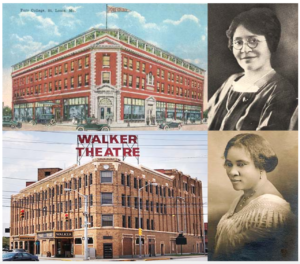
Poro and Walker Building
For a variety of reasons, the now century old rivalry between Madam Walker and Annie Pope-Turnbo Malone continues posthumously with people taking sides in unresolved battles on social media. Most of the time, I try to stay on the sidelines because I long ago learned that it is impossible to change the mind of someone who has no interest in looking at facts and documentation. But for those of you who are open to considering facts, I offer the following information:
There’s no doubt in my mind that Madam C. J. Walker and Annie Malone both are important historical figures who made major contributions as early twentieth century hair care industry pioneers and philanthropists. It is true that Madam Walker sold Malone’s Poro products in St. Louis and in Denver in 1905 and 1906 before marrying Charles Joseph “C.J.” Walker and starting her own Madam C. J. Walker Manufacturing Company. It’s also true that Walker was first introduced to the hair care business in the 1890s by her brothers, who were barbers in St. Louis. As well, it is true that neither Annie Malone or Madam Walker was the first to discover the system of cleansing one’s scalp, then applying a thick ointment that was the consistency of Vaseline — with sulfur as the medicinal agent — to heal the severe scalp infections that were rampant in the early 1900s. It was a time when hygiene was quite different because most Americans lacked in door plumbing. In fact, the remedy they both used had been around for centuries. The basic recipe appears in medical texts as early as the 1700s and was used in other products including Cuticura as well as those manufactured by other black-owned companies during the 1800s. As amazing as both women were, neither was the first to manufacture hair care products for black women. Just a little bit of thought makes it clear that black women had been styling their hair since ancient times.
As a long time journalist and as a biographer who writes non-fiction (i.e. FACT-based) books, I also believe it is important to document one’s assertions and to present accurate information…even on social media where myths and misinformation abound.
Much of the primary source research about the relationship between Walker and Malone first appeared in my book, On Her Own Ground: The Life and Times of Madam C. J. Walker (Scribner, 2001). I was careful to include citations for the newspaper articles and correspondence that documented my assertions in very detailed endnotes. More recently, I wrote a blog post “Madam Walker’s Mentors, Sister Friends and Rivals” that adds to the information about Walker and Malone, as well as the women to whom Walker was close, like St. Louis school teacher Jessie Batts Robinson and anti-lynching activist Ida B. Wells.
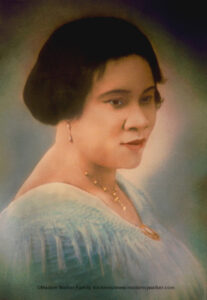
Madam C. J. Walker (Credit: Madam Walker Family Archives)
SALES FIGURES FOR MADAM WALKER AND ANNIE MALONE: Since the publication of On Her Own Ground, other authors have written books and articles about Annie Malone. A few years ago, I began to notice “$14 million” as a claim for Malone’s net worth, first in Neema Barnette’s mini-doc video about Malone and then in articles and on social media posts. In 2018, Shomari Wills made the same claim in his book, Black Fortunes: The Story of the First Six African Americans Who Escaped Slavery and Became Millionaires, a poorly researched and error-filled book that had to be revised by his publisher because of the easily found mistakes. For reasons that elude me, he distorted the details of Madam Walker’s life and entirely upended the facts of her appearance and impact at the 1912 National Negro Business League convention.
Because that “$14 million” figure that Wills and others used was new to me, I did additional research to try to learn the origin of the claim. In addition to research I had been gathering for more than 40 years about Walker and Malone, I did an extensive survey of historical newspaper databases on Newspapers.com, Proquest and Genealogybank.com, which now include dozens of black newspapers from the late 1800s and early 1900s.
The first time I was able to find a reference to the $14 million figure was in a 1957 Chicago Defender obituary (“Annie T. Malone Rites at Bethel,” Chicago Defender, May 15, 1957), which read: “Once regarded as the world’s richest Negro woman, her wealth at the peak of her career in the 1920s was estimated at $14 million.”
Two weeks later, the Defender repeated the $14 million figure in another article “How Annie Malone Made, Lost a Fortune.”
In December 1962, the Defender again repeated the $14 million figure.
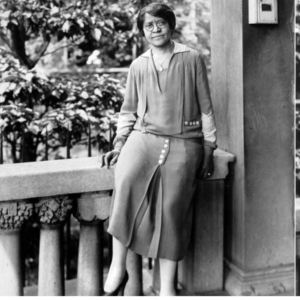
Annie Malone
But no documentation or business records for this claim were cited in the articles and the figure had never appeared in newspaper reports prior to Malone’s death in 1957. Without such documentation or prior contemporaneous reporting during Malone’s lifetime, the figure seems to be drawn from thin air.
Just as misinformation goes viral today, it seems to have gone viral in 1957 and then to have been resurrected in 2020.
When On Her Own Ground first was published in 2001, I estimated Madam Walker’s personal wealth (homes, real estate investments, jewelry, cars, clothing, furniture, etc) to be between $600,000 and $700,000. However, a business historian pointed out to me a year later that I had failed to include the value of Madam Walker’s company in my estimation of her wealth. When one takes into account the sales for the last two years of her life and the year following her death, I was advised that the value of her company, had it been sold on the day of her death, would have been between $1 million and $2 million in 1919 dollars.
Here are the gross receipts for 1918 – 1920 (as documented in Walker Company annual reports and tax records in our Madam Walker Family Archives and in the Walker Collection at the Indiana Historical Society):
1918 earnings: $275,937.88 (an increase of $100,000 from 1917)
1919 earnings $486,762
1920 earnings: $595,353 (or $9,272,135.87 in 2020 according to Dollar Times Calculator)
We are fortunate that we can document Madam Walker’s sales because of the voluminous records that were preserved from the Madam C. J. Walker Manufacturing Company. Unfortunately, similar documentation does not exist for the Poro Company. Unless such records surface, there is no way to prove the claims about Malone’s wealth.
During the last four decades, I’ve created a file of hundreds of articles that mention Malone or Poro between 1903 and the time of her death in 1957. Some of those articles quote officials of the Poro Company regarding the claims for annual sales and company value. I have not found any articles prior to Madam Walker’s death in 1919 or Annie Malone’s death in 1957 that claimed that Malone was “worth $14 million.”
Instead I have found the following:
In November 1913 the Cleveland Gazette, where Annie (then Pope-Turnbo) frequently advertised, the Doings of the Race columnist wrote, “An expert going over the books found the receipts from the sale of hair preparations and agents fees total from $100 to $150 per day.” The Chicago Defender also carried a story giving the $100 to $150 per day” figure.
That $100 to $150 per day would be between $36,500 and $54,750 annually if received seven days a week or between $26,100 and $39,150 annually based on Monday through Friday receipts.
In August 1915, in response to a law suit brought by Walter Majors (a former Malone business partner who sued her for reneging on a share of the 1913 profits she had promised him), a report of the earnings of the previous 33 months was $63,650.03 gross with $24,333.60 net. Another article says the period was “fourteen months” with a “monthly net profit of $1,738.” (14 x $1,738 = $24,333.60).
1918: “A $50,000 Corporation with $250,000 Yearly Business…From last year’s statistics, presented [to] the Bee reporter, is shown in round numbers $250,000 business done.” (“Notable Career of Prof. and Mrs. A.E. Malone,” Washington Bee, August 31, 1918) [Walker’s gross receipts that year, as documented in the annual report prepared by her attorney, were $275,937.88.]
1924: In November, the Topeka Plaindealer reported that Malone had “paid $38,408 income tax for 1923. Her business represents an investment of $750,000.” (“She Is Solving the Race Question,” Plaindealer (Topeka, KS), November 14, 1924)
1926 “Mrs. Malone is probably the Race’s leading business woman and is known to be worth several millions of dollars.” [though I will point out that this reporter cites no documentation] (“Former Banker’s Home Brings Nearly $50,000,” Philadelphia Tribune, Jan 30, 1926)

Aaron Malone and Annie Pope Turnbo married in 1914
WHY IS MADAM WALKER MORE WELL-KNOWN THAN ANNIE MALONE: There are many possible reasons why Madam Walker is more well-known today than Annie Malone. Madam Walker died at the height of her fame in May 1919 with her wealth intact while Malone experienced business and reputational setbacks during the 1920s after a contentious divorce from Aaron Malone, who worked to turn some of her employees against her and to undermine her leadership role.
Madam Walker had a knack for hiring and empowering strong leaders who enhanced her company. Her carefully selected executive team included Freeman B. Ransom, the attorney who guarded against legal threats, while Malone was involved in a decades long lawsuit brought by Walter Majors, a former business partner, who accused her of failing to pay a portion of profits promised to him in 1913. (Among the articles that document this legal battle is “Referee Finds Against Beauty Specialist,” Indianapolis Freeman, August 28, 1915.)
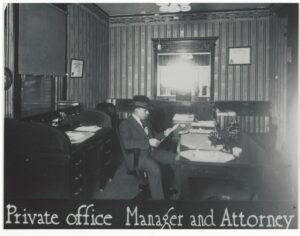
Madam C. J. Walker Mfg. Co. Atty F. B. Ransom circa 1912 (Madam Walker Family Archives)
While Attorney Ransom steadfastly paid Madam Walker’s personal and corporate federal income taxes, Malone disputed her federal tax assessment and faced a large unpaid federal tax bill during the 1940s.
Madam Walker’s secretary Violet Davis Reynolds, who worked for the Walker Company from 1914 until 1979, kept meticulous records and preserved thousands of Walker’s personal letters and financial documents, which are housed at the Indiana Historical Society. There is no comparable body of records for Annie Malone or the Poro Company.
Madam Walker advertised heavily in the black press and cultivated relationships with black editors and publishers. Like her contemporaries Helena Rubinstein and Elizabeth Arden, she created national distribution platforms for her products. She traveled to the Caribbean and Central America in 1913 to expand her market internationally.

Madam Walker advertised in dozens of black newspapers.
Another factor may be her daughter A’Lelia Walker’s suggestion that they establish a presence in Harlem in 1913 just as this uptown Manhattan neighborhood was becoming a political and cultural mecca for African Americans. A’Lelia Walker operated the Walker Beauty School and Salon in Harlem, then converted a floor of their 136th Street townhouse into The Dark Tower, which became an iconic gathering place for the artists, writers, musicians, actors and celebrities of the Harlem Renaissance.
By the mid-1970s most of the Poro and Walker Beauty Schools had closed. I have not been able to determine when the Poro Company stopped manufacturing its line of hair care products. The Madam C. J. Walker Manufacturing Company never went out of business. The trademark was sold by the Madam Walker trustees in the early 1980s to an entity that manufactured some of the original formulas for the next three decades.

MADAM by Madam C. J. Walker at Walmart
In 2013 Richelieu Dennis, founder of Sundial Brands, acquired the Walker trademark for cosmetics and hair care products and revived the line with all new formulas. Today the MCJW line is sold exclusively at Walmart stores and at Walmart.com.
Madam Walker’s legacy also benefits from two very tangible reminders. The Madam Walker Legacy Center in Indianapolis is a National Historic Landmark. Villa Lewaro, the mansion designed by architect Vertner Tandy (a founder of Alpha Phi Alpha), is both a National Historic Landmark and one of the National Trust for Historic Preservation’s designated National Treasures.

Villa Lewaro, estate of Madam C. J. Walker, 1924 (Madam Walker Family Archives0
So who was first? Madam Walker or Annie Malone? If you’ve made it this far in the article, you know that Madam Walker’s wealth can be documented while Annie Malone’s can not. My personal perspective is that Madam Walker’s legacy is measured more in the jobs she created, the philanthropy she dispensed, the lives she changed and the seeds she planted for political activism than in whether she was “the first self-made American woman millionaire,” as the Guinness Book of World Records states.
So those who want to keep arguing this point can have at it.
If you’re interested in learning more about Madam Walker and what’s truly important about her legacy, we urge you to read the new edition of On Her Own Ground: The Life and Times of Madam C. J. Walker or listen to the audio book that I recently recorded. If you happen to be in Indianapolis, we hope you’ll visit the Madam Walker Legacy Center and the Indiana Historical Society where a major exhibit — “You Are There: Madam Walker 1915 Empowering Women” — is up until January 2021.
*Malone was born in 1877. This is a correction.
On Sunday morning, May 25, 1919 – exactly 100 years ago this weekend – Madam C. J. Walker died at Villa Lewaro, her Irvington-on-Hudson, New York estate.
A few hours later in black churches across America, ministers talked of her journey from deep poverty in the cotton fields of Delta, Louisiana to president of the international Madam C. J. Walker Manufacturing Company. It was such big news that the announcement also was made at a Negro League baseball game in Chicago that afternoon.

Madam C. J. Walker died on May 25, 1919 at Villa Lewaro, her Irvington, NY estate.
She was born Sarah Breedlove on December 23, 1867 on the same plantation where her parents and older siblings had been enslaved before the end of the Civil War. The first child in her family born into freedom, she would become a millionaire who bequeathed more than $100,000 to her community, including $5,000 to the NAACP’s anti-lynching fund.
By providing job opportunities for the nearly 20,000 sales agents and beauty culturists who sold her Wonderful Hair Grower, she helped them become economically independent. She used her wealth and influence as a philanthropist, patron of the arts and political activist to support black institutions and organizations.
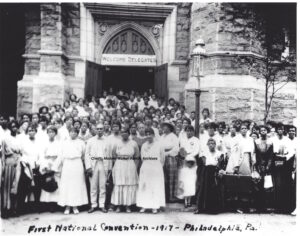
Madam Walker at her first national convention of her sales agents and beauty culturists in 1917.
At her 1917 national convention, she told the delegates that their “first duty” as Walker associates “was to humanity.” During the final session, she and her agents dispatched a telegram to President Woodrow Wilson urging him to support legislation to make lynching a federal crime.
Madam Walker’s funeral on May 30 was a dignified gathering with pallbearers who represented black America’s most prominent civil rights, business and religious leaders. Walker Company employees and agents filed quietly and reverently past her casket in the music room at Villa Lewaro as J. Rosamond Johnson sang “Since You Went Away,” the spiritual he had composed with his brother, James Weldon Johnson.
This year as we observe the centennial of Madam Walker’s death, there is much to remind us of the powerful inspiration her legacy still provides.
Throughout 2019 and 2020 we’ll celebrate with several events including
*the launch of new products in Sundial’s MCJW hair care line at Sephora.com

MCJW, the Madam Walker line of hair care products created by Sundial Brands.
*the re-opening of the renovated Madam Walker Legacy Center in Indianapolis
*the September 19 opening of a Madam Walker exhibition at the Indiana Historical Society in Indianapolis
*the renaming this summer of 136th Street between Lenox and Seventh Avenue in Harlem
*the digitization of 40,000 items from the Madam Walker Collection of letters, photographs, business records and ephemera at the Indiana Historical Society
This spring we’ve already had help celebrating with
*a featured segment about Madam Walker in Stanley Nelson’s PBS documentary, “BOSS: The Black Experience in Business”
*Harlem Eat Up Luminary Award to Madam Walker
*”What Madam Taught Us” in the May issue of Essence
*AAIHS’s five-part Black Perspectives blog forum with articles by scholars who bring new perspectives on Madam Walker’s life
*Our interview with Georgia Public Broadcasting’s Morning Edition host Leah Fleming
ABC News Now’s segment about Villa Lewaro
Ronda Racha Penrice’s NBC BLK feature on Madam Walker
During the last four decades in my role as Madam Walker’s biographer, it has been a joy for me to share her story with a range of audiences from elementary school students and Harvard Business School classes to corporate CEOs and women in the college course at Bedford Hills Correctional Facility.
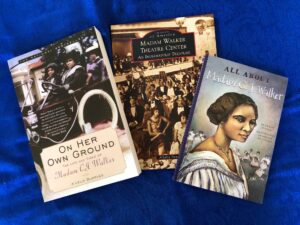
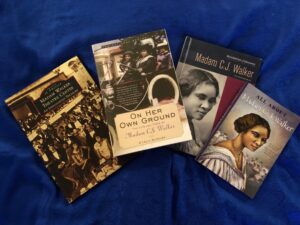
Madam Walker biographies by A’Lelia Bundles
I’m grateful that my book, On Her Own Ground: The Life and Times of Madam C. J. Walker (Scribner/Lisa Drew 2001), is considered the most reliable source for accurate information about Madam Walker and that elementary school students can learn about her in All About Madam C. J. Walker (Cardinal/Blue River Press 2018).
Knowing that Villa Lewaro soon will become a think tank for women of color entrepreneurs under the auspices of the New Voices Foundation brings the story full circle just as Madam Walker dreamed when she moved into the house in 1918.
Follow us on Twitter at @aleliabundles @mcjwbeauty @madamcjwalker
Follow us on Instagram at @aleliabundles @mcjwbeauty
A’Lelia Bundles is Madam C. J. Walker’s great-great-granddaughter and biographer.
Today — December 23, 2015 — is the 148th anniversary of Madam C. J. Walker’s birth!
She was born Sarah Breedlove on December 23, 1867 in Delta, Louisiana on the same planation where her parents Owen and Minerva Anderson Breedlove had been enslaved. The first child in her family to be born after the Emancipation Proclamation of 1863, her birth was greeted with much hope and promise. But the Breedlove family’s reality was bleak. 
By the time Sarah was seven years old, both parents had died. At ten, she moved across the Mississippi River to Vicksburg, Mississippi with her older sister, Louvenia, and her brother-in-law, Jesse Powell, who was so cruel, she would later say, that she “married at 14 to get a home of my own.” Another blow came with the death of her husband, Moses McWilliams, when she was 20. Now with her two-year old daughter, Lelia (later known as A’Lelia Walker) to raise, she moved up the river to St. Louis, Missouri where her older brothers worked as barbers.
She struggled for the next decade working as a laundress, doing the back-breaking work of washing clothes by hand in tubs and without indoor plumbing. At the end of some weeks, she’d made as little as $1.50, but her dreams for her daughter made her persevere. One day while her hands were buried deep in soap suds, she despaired that life might never get better. But the solution to her problems eventually came when she developed a shampoo and ointment to heal the scalp disease that was causing her to go bald.

Madam Walker died at Villa Lewaro in May 1919.
By the time she died on May 25, 1919 at Villa Lewaro (her mansion in Irvington-on-Hudson, New York), she had founded the Madam C. J. Walker Manufacturing Company and become a millionaire, some say the first self-made American woman to attain that level of financial success.
There is much more to her story of course. How she discovered, developed and marketed her “Wonderful Hair Grower.” How she employed thousands of women as Walker sales agents and beauty culturists. How she spoke up to Booker T. Washington at his 1912 National Negro Business League Convention. How she gathered more than 200 women together for one of America’s first national conventions of women entrepreneurs in 1917. Her prominence as a philanthropist and patron of the arts. Her friendships with Ida B. Wells, W.E.B. DuBois, Mary McLeod Bethune and James Weldon Johnson among others. Her $1,000 contribution to Indianapolis’s YMCA and $5,000 to the NAACP’s anti-lynching campaign. Her activism on behalf of black soldiers, young women and the rights of African Americans.
Her legacy of entrepreneurship and philanthropy still empowers others. She is often mentioned by businesswomen in America and beyond as an inspiration. Her company is discussed and critiqued in a Harvard Business School course. Dozens of students across the nation prepare projects about her every year for National History Day. Countless young girls have dressed up as Madam Walker for Black History Month and Women’s History Month. She is the subject of numerous documentaries, public service announcements and news stories. Several organizations host annual Madam Walker awards luncheons. The Madam Walker Collection of photographs, letters and business records is the most popular collection at the Indiana Historical Society. She was featured on a U. S. postage stamp in 1998. Recently her name was touted as contender for the $20 bill. There are two National Historic Landmarks associated with her life: Villa Lewaro in Irvington-on-Hudson, New York and the Madam Walker Theatre Center in Indianapolis, Indiana.
Here are some of the books in which she has been featured or mentioned in the last couple of years. 
Angella M. Nazarian’s Visionary Women (Assouline Publishers)
Cynthia L. Greene’s Entrepreneurship: Ideas in Action (Cengage Learning)
Faith Ringgold’s Harlem Renaissance Party (Amistad)
James J. Madison and Lee Ann Sandweiss’s Hoosiers and the American Story (Indiana Historical Society)
Martin Kilson’s Transformation of the African American Intelligentsia 1880 – 2012 (Harvard University Press)
Diane Radmacher’s Famous Firsts of St. Louis: A Celebration of Facts, Figures, Food & Fun
As we approach the 150th anniversary of her birth, we can say there are more exciting announcements to come in the new year. Stay tuned!
Other blog posts that might interest you
A Family Perspective: Celebrating Madam Walker’s Legacy
Madam Walker’s 1917 Convention: Entrepreneurship and Protest Politics
Madam Walker’s Mansion: The Future of Villa Lewaro
Madam Walker’s August Garden
Woodlawn Cemetery — Burial Place of Madam Walker — Designated National Historic Landmark
Madam Walker Visits the Brothers Dumas in Mississippi
Madam Walker Black History Month 2013
To learn more about Madam Walker, visit our official Madam C. J. Walker website at www.madamcjwalker.com
To order On Her Own Ground: The Life and Times of Madam C. J. Walker and Madam Walker Theatre Center, visit my website at www.aleliabundles.com
Here’s a link to videos about Madam Walker.
Check out Madam Walker on Facebook.
During the week of October 19, 2014 the National Trust for Historic Preservation featured Villa Lewaro, Madam Walker’s Irvington-on-Hudson, New York estate, on all its social media platforms. This piece that I wrote for the Trust’s Preservation Blog also appeared on Huffington Post and Jet.com

Inside Villa Lewaro, Madam C. J. Walker’s Irvington-on-Hudson, NY mansion (David Bohl/Historic New England)
Every time I walk through the doors of Villa Lewaro—the mansion my great-great-grandmother, Madam C. J. Walker, called her “dream of dreams”—I always take a moment to imagine the pride and magic the ancestors must have felt in these rooms. From the columns of the majestic portico to the balustrades of the grand terrace, the original stucco façade sparkled with marble dust and glistening grains of white sand when the laundress-turned-millionaire took possession in May 1918.

Villa Lewaro 1920s
The New York Times pronounced it “a place fit for a fairy princess.” Enrico Caruso, the world famous opera tenor, was so entranced by its similarity to estates in his native Naples that he coined the name “Lewaro” in honor of A’Lelia Walker Robinson, Madam Walker’s only daughter.
Walker told her friend Ida B. Wells, the journalist and anti-lynching activist, that after working so hard all her life—first as a farm laborer, then as a maid and a cook, and finally as the founder of an international hair care enterprise—she wanted a place to relax and garden and entertain her friends.
She also wanted to make a statement, so it was no accident that she purchased four and a half acres in Irvington-on-Hudson, New York not far from Jay Gould’s Lyndhurst and John D. Rockefeller’s Kykuit amidst America’s wealthiest families. She directed Vertner Woodson Tandy—the black architect who already had designed her opulent Harlem townhouse—to position the 34-room mansion close to the village’s main thoroughfare so it was easily visible by travelers en route from Manhattan to Albany.

Villa Lewaro Aerial (Courtesy Madam Walker Family Archives)
Indeed, the Times reported that her new neighbors were “puzzled” and “gasped in astonishment” when they learned that a black woman was the owner. “Impossible!” they exclaimed. “No woman of her race could afford such a place.”
The woman born in 1867 in a dim Louisiana sharecropper’s cabin on the banks of the Mississippi River, now awoke each morning in a sunny master suite with a view of the Hudson River and the New Jersey Palisades. The child who had crawled on dirt floors now walked on carpets of Persian silk. The destitute washerwoman, who had lived across the alley from the St. Louis bar where Scott Joplin composed ragtime tunes, now hosted private concerts beneath shimmering chandeliers in her gold music room.
But the home was not constructed merely for her personal pleasure. Villa Lewaro, she hoped, would inspire young African Americans to “do big things” and to see “what can be accomplished by thrift, industry and intelligent investment of money.”
“Do not fail to mention that the Irvington home, after my death, will be left to some cause that will be beneficial to the race—a sort of monument,” she instructed her attorney, F. B. Ransom. As the largest contributor to the fund that saved Frederick Douglass’s Anacostia home, Cedar Hill, she understood the importance of preservation as a strategy to claim and influence history’s narrative.

Invitation to the August 1918 Villa Lewaro gathering honoring Emmett Scott (Courtesy Madam Walker Family Archives)
For her opening gathering in August 1918, Madam Walker honored Emmett Scott, then the Special Assistant to the U. S. Secretary of War in Charge of Negro Affairs and the highest ranking African American in the federal government. At this “conference of interest to the race”—with its Who’s Who of black Americans and progressive whites—she encouraged discussion and debate about civil rights, lynching, racial discrimination and the status of black soldiers then serving in France during World War I. After a weekend of conversation, collegiality and music provided by J. Rosamond Johnson—co-composer of “Lift Ev’ry Voice and Sing”—and Joseph Douglass, master violinist and grandson of Frederick Douglass, Scott wrote to her, “No such assemblage has ever gathered at the private home of any representative of our race, I am sure.”
After Madam Walker died at Villa Lewaro on May 25, 1919—barely a year after moving in—her daughter continued the tradition of hosting events, occasionally opening the home for public tours to honor Walker’s legacy. Later dubbed the “joy goddess of Harlem’s 1920s” by poet Langston Hughes because of her impressive soirees, A’Lelia Walker feted Liberian President Charles D. B. King and his entourage in 1921 with a Fourth of July fireworks display and concert by the Ford Dabney Orchestra. In November 1923, limousines lined Broadway as several hundred bejeweled and fancily dressed wedding reception guests arrived from Harlem’s St. Philips Episcopal Church where my grandmother Mae had married her first husband, Dr. Gordon Jackson. The following summer, more than 400 sales agents and cosmetologists journeyed from all over the United States and the Caribbean for the eighth annual convention of the Madam Walker Beauty Culturists Union.

A’Lelia Walker in Villa Lewaro’s Music Room (Courtesy of Madam Walker Familly Archives)
In the late 1970s, as I was beginning to research the Walker women’s lives, I made my first visit to the house. Sold soon after A’Lelia Walker’s death in 1931 in the midst of the Great Depression, it had been a retirement home for elderly white women for several decades. Even with its beauty then obscured and its furnishings meager, I still could see the lingering grandeur in the hand-painted murals and the marble stairs. When I interviewed blues legend Alberta Hunter a few years later, she told tales of elegant weekend parties and of playing the Estey organ as she gently awakened the other guests.
Through the years I’ve watched as ownership has moved from the Companions of the Forest to Ingo and Darlene Appel and then to Harold and Helena Doley. They all have been stewards in their own caring way. For more than two decades, the Doleys have invested considerable resources and patience to restore the home and the grounds, even hosting a designer show house benefitting the United Negro College Fund in 1998.

In May 1922 the National Trust for Historic Preservation and the Rockefellers Brothers Fund hosted a gathering of preservationists, developers and entrepreneurs to discuss the future of Villa Lewaro.
Among the earliest and most notable mansions built and owned by an African American and by an American woman entrepreneur, Villa Lewaro is one of the few remaining tangible symbols of the astonishing progress made by the generation born just after Emancipation and the Civil War. Without this evidence, our history can be intentionally misinterpreted and easily dismissed. Having walls to touch and doors to open helps our children and grandchildren verify the ancestors’ accomplishments and connect themselves to their rich heritage.
It is vital that we work to find ways to imagine Villa Lewaro’s future so that it can continue to inspire others and to be, as Madam Walker dreamed “a monument to brains, hustle and energy…and a mile stone in the history of a race’s advancement.”
To support these efforts, please click here to sign the pledge to preserve Madam Walker’s Villa Lewaro and here to make a monetary donation through the National Trust.
A’Lelia Bundles is Walker’s great-great-granddaughter and author of On Her Own Ground: The Life and Times of Madam C. J. Walker. Her website is www.aleliabundles.com

Langston Hughes called A’Lelia Walker “the joy goddess of Harlem’s 1920s.”
Many thanks to Quintard Taylor and BlackPast.org for inviting me to write an essay about A’Lelia Walker for Black History Month 2014. Here is the essay as it appears on the website. And please do visit this wonderful, information website for hundreds of articles that make Black History Month last all year long. Click HERE to go the A’Lelia Walker essay, which is posted below:
In the following account based on her forthcoming book on A’Lelia Walker titled The Joy Goddess of Harlem: A’Lelia Walker and the Harlem Renaissance, A’Lelia Bundles provides a glimpse into the life of her famous great-grandmother whose own powerful story is often overshadowed by accounts of her mother, cosmetics entrepreneur Madam C.J. Walker. I first began to learn about my great-grandmother and namesake, A’Lelia Walker, when I was three or four years old. On visits with my mother to my grandfather’s apartment, I always slipped away to explore a chest of drawers filled with her jewelry, clothes, photographs and opera glasses. Later I discovered that the baby grand piano on which I learned to read music had been played by famous musicians who visited her Harlem home. The first edition copies of
Countee Cullen’s
Color and
Jean Toomer’s
Caneon our bookshelves had come from her personal library.
To the wider world, she was a cosmetics industry executive and patron of the arts. Born Lelia McWilliams on June 6, 1885 in Delta,
Louisiana, she was the only child of future hair care entrepreneur and philanthropist
Madam C.J. Walker (Sarah Breedlove), and Moses McWilliams, a sharecropper. As an adult, she changed her name to A’Lelia.
In 1888, while still a toddler, she moved with her widowed mother from Vicksburg,
Mississippi to St. Louis,
Missouri,

St. Louis
where three of her maternal uncles operated a barber shop. At nearby St. Paul African Methodist Episcopal Church, women parishioners reached out, caring for A’Lelia in the St. Louis Colored Orphans Home while Sarah worked during the week as a washerwoman. As a choir member, Sarah was exposed for the first time to educated, urban, middle class African American women, many of whom were members of the National Association of Colored Women. Motivated by these interactions, she began to aspire to a better life for herself and her daughter. Sarah’s marriage to an abusive alcoholic named John Davis during A’Lelia’s adolescence created instability and frequently disrupted her school attendance.
In 1901, when A’Lelia was 16, her mother left Davis. She then sent A’Lelia to
Knoxville College in
Tennessee, where she remained for less than a year.A’Lelia Walker’s love of music and theatre, which later would inform her philanthropy, was established long before she attended college. During the late 1890s, she and her mother had lived across the alley from Tom Turpin’s
Rosebud Café, the St. Louis piano hall where ragtime composer
Scott Joplin often performed.

During the late 1890s, A’Lelia Walker and her mother, who then was still a washerwoman, lived across the alley behind this building which housed Tom Turpin’s Rosebud Cafe.
Her elementary school principals included black Oberlin College graduates who exposed A’Lelia and the other children to opera, German lieder, marches and spirituals. St. Paul’s organist was a classically-trained tenor who appeared in black British composer Samuel Coleridge-Taylor’s opera Hiawatha at the 1893 Chicago World’s Exposition. Among her childhood friends were Porgy and Bess cast member Georgette Harvey and musicians Sam Patterson, Joe Jordan, and Louis Chauvin.In 1906, 21-year-old A’Lelia joined her mother and new stepfather, Charles Joseph Walker, in Denver, Colorado, where they recently had founded the Madam C.J. Walker Manufacturing Company, a hair care products firm that soon would become one of America’s most successful women-owned and black-owned companies.
To identify herself with her mother’s increasingly successful business, A’Lelia began using the Walker surname, though she never was legally adopted by Charles Walker. In Denver and then in Pittsburgh, Pennsylvania, as her mother traveled, she oversaw the mail order operation and manufacture of the Walker line of products. In 1909 she married hotel employee John Robinson whom she had met in Pittsburgh, but the union ended after three years.

Madam Walker opened Lelia College, her first beauty school on Wylie Avenue in 1908. (This photo from agatetype.com was shot in 1912.)
When Madam Walker moved her headquarters to Indianapolis, Indiana in 1910, A’Lelia remained in Pittsburgh to manage the company’s east coast operations. During this time, she adopted 13-year-old Fairy Mae Bryant, whose widowed biological mother had allowed her to travel with the Walkers as an assistant and model. Her hip-length braids were featured in Walker ads for their Wonderful Hair Grower, a product that healed dandruff and scalp disease. She became known as Mae Walker, later graduated from Spelman Seminary (now Spelman College) and was a Walker Company executive for more than 25 years.
In 1913 A’Lelia Walker convinced her mother to establish a Harlem office just as African Americans were moving into that uptown Manhattan neighborhood. Like her mother, she became involved in philanthropic activities, heading fundraising campaigns for several charitable causes, including an ambulance for black soldiers during World War I and a building for the Utopia Neighborhood Club’s Child Welfare and Recreation Center, which later served as the New York headquarters for the 1963 March on Washington. With Lucille Randolph—a Walker-trained beautician and wife of publisher and activist A. Philip Randolph—she founded the Harlem Debutantes Club as a vehicle to involve her daughter, Mae, and other young women from the community in social service activities.

Walker townhouse at 108-110 W. 136th Street. Today the space is occupied by the Countee Cullen branch of the NY Public Library.
Both Walker women cultivated relationships with black publishers and advertised extensively in The Messenger, The Crisis, the New York Age, the Baltimore Afro-American, the Pittsburgh Courier, the Chicago Defender and dozens of other newspapers.In 1916 when Madam Walker moved from Indianapolis to Harlem, she joined A’Lelia at 108-110 West 136th Street in a townhouse, office and beauty salon near Lenox (now Malcolm X) Avenue designed for them by architect and Alpha Phi Alpha founder Vertner Tandy. Two years later she moved into another Tandy-designed home, a 34-room mansion in Irvington-on-Hudson, New York, 18 miles north of Harlem. Legendary tenor Enrico Caruso suggested the name Villa Lewaro in honor of A’Lelia (A’Lelia Walker Robinson). Madam Walker’s presence in the New York office resulted in conflict, however, as she sometimes usurped her daughter’s authority in business decisions involving their local sales agents. A long-time employee described their relationship in this way: “Fire and ice. They loved each other dearly and they sometimes fought fiercely.”
On May 25, 1919, while A’Lelia and Mae were en route home from a business trip to Panama, Madam Walker died, leaving A’Lelia as the 34-year-old company president and heiress of an estate and homes valued at a million dollars.

A’Lelia Walker was in Colon, Panama when her mother died on May 25, 1919.
Devastated by her mother’s death, she immediately married Dr. Wiley Merlio Wilson, a Howard University-trained physician and pharmacist, whom she had met several years earlier when he and his brother ran businesses in Pine Bluff, Arkansas and St. Louis. As a wedding gift, she purchased a building for his medical clinic, Wilson Sanitarium, at 138th and Seventh Avenue in one of the Strivers Row blocks. They divorced in 1924. Two years later, she married Dr. James Arthur Kennedy, a decorated World War I captain, who later became the assistant director at Tuskegee’s Veteran’s Hospital.
With her sizeable fortune backed by the Walker hair care products empire, A’Lelia Walker became a patron of the newly emerging Harlem Renaissance of the 1920s. She hosted some of the most memorable parties of that decade, lending a glamorous, glitzy aura to the social scene above 110th Street.

The invitation A’Lelia Walker sent to hundreds of friends when she converted a floor of her 136th Street townhouse into a cultural salon called The Dark Tower in October 1927. (Madam Walker Family Archives)
At the Dark Tower—a converted floor of her 136th Street townhouse named for Cullen’s Opportunity column and poem—and at her 80 Edgecombe Avenue pied-á-terre, she welcomed Harlem and Greenwich Village writers, artists, actors, and musicians at a time when blacks and whites seldom socialized on equal terms.
Also, during an era when few women traveled alone, A’Lelia Walker visited Africa, Europe, the Middle East, the Caribbean and Central and South America. On a transatlantic voyage on the luxury liner Paris in late 1921, she occupied the first class cabin next to French Prime Minister Aristide Briand. In 1922 she witnessed the coronation of Pope Pius XI in Rome, Italy and became the first American to meet Empress Zewditu I in Addis Ababa, Ethiopia.

A’Lelia Walker visited Ethiopian Empress Zewditu in March 1922.
As a patron of the arts, she supported J. Rosamond Johnson’s Harlem Music School Settlement which offered classical music training for black students. Musicians James Reese Europe, Ford Dabney, Joseph Douglass, Harry T. Burleigh, Turner Layton, and Alberta Hunter performed at her dinners and parties. She also opened her home to theatrical rehearsals, movie shoots and art exhibitions. Among the photographers whose careers she promoted were R. E. Mercer and James Allen. At various times, actress Edna Lewis Thomas, author Eric Walrond, and singer Taylor Gordon lived rent-free at her Harlem house.
The best known black socialite of her time, A’Lelia Walker was such a rarity that Harlem Renaissance writer Langston Hughes called her “the joy goddess of Harlem’s 1920s” and noted that her parties “were filled with guests whose names would turn any Nordic social climber green with envy.” In April 1929, composer Max Ewing wrote, “Wherever else one is invited or expected, one must cancel all other plans if invited to A’Lelia’s! She is the Great Black Empress, She Who Must Be Obeyed!”

A’Lelia Walker served as inspiration for many photographers, artists and novelists. (Photo: Madam Walker Family Archives)
A’Lelia Walker personified the spirit and flamboyance of the Harlem Renaissance. Her always stylish appearance, which mixed regal, statuesque African beauty with haute couture, inspired poets, novelists, and painters. “She had a superb figure, the type that artists like to draw,” said a reporter who knew her well. Among those for whom she posed were photographer Berenice Abbott and sculptors Richmond Barthé and Augusta Savage. With admiration, close friend Langston Hughes called her a “gorgeous dark Amazon,” a phrase fraught with powerful meaning in an era when light-skinned African Americans often were perceived as more beautiful by many blacks and most whites. Literary critic Carl Van Vechten and Renaissance authors Zora Neale Hurston, George Schuyler, and Wallace Thurman created characters inspired by her.
As the first internationally visible black American heiress with celebrity status, she displayed an impresario’s gift for staging elaborate extravaganzas that made headlines, filled society gossip columns, and scandalized the more straitlaced social arbiters and race leaders of her mother’s generation. Her most memorable affairs included her daughter Mae’s lavish 1923 nuptials to Dr. Gordon Jackson, son of Niagara Movement treasurer George Jackson, and a fireworks-filled 1921 Fourth of July celebration at Villa Lewaro for C.D.B. King, the President of Liberia.
Like other entrepreneurs and art patrons of the era, A’Lelia Walker basked in the euphoria of the Jazz Age and like many of her contemporaries she personally felt the 1929 stock market crash and ensuing Great Depression. During this period as Walker Company sales plunged, her long-troublesome hypertension worsened. In 1931 she divorced Dr. James Arthur Kennedy.
Like many children of self-made figures, she struggled to define herself outside the sphere of her mother’s influence, expectations and legacy. On August 17, 1931, after an enjoyable day celebrating a friend’s birthday at the beach in Long Branch, New Jersey, A’Lelia Walker died from a cerebral hemorrhage.

A’Lelia Walker died in a private cottage near the beach in Long Branch, NJ in August 1931. (This photo from historiclong branch.org was taken in July 1930.)
A few days later, several thousand New Yorkers crowded the streets outside the Harlem funeral parlor where her body lay in repose. As her casket was lowered into the crypt next to her famous mother at Woodlawn Cemetery in the Bronx, aviator Hubert Julian, known as “The Black Eagle,” flew over the site releasing dahlias and gladiolas. Of her death, Langston Hughes wrote “That was really the end of the gay times of the New Negro era in Harlem…The depression brought everybody down a peg or two. And the Negroes had but few pegs to fall.”
Sources:
A large collection of A’Lelia Walker’s letters, photographs, financial records, clothes and personal effects are in the author’s Madam Walker/A’Lelia Walker Family Archives in Washington, DC. Several dozen additional personal letters and other Walker Company materials are in the Madam C. J. Walker Collection at the Indiana Historical Society. Details of Walker’s life, especially prior to 1920, are included in On Her Own Ground: The Life and Times of Madam C. J. Walker (Scribner 2001) by A’Lelia Bundles, whoseThe Joy Goddess of Harlem: A’Lelia Walker and the Harlem Renaissance, is forthcoming from Scribner in 2015. Articles and photographs also appear at https://aleliabundles.com/ and http://www.madamcjwalker.com/. Langston Hughes’s The Big Sea (1940) and Carl Van Vechten’s unpublished New Yorker profile in “Keep A-Inchin’ Along”: Selected Writings of Carl Van Vechten about Black Art and Letters, ed. Bruce Kellner, provide useful accounts of her later life.

































Recent Comments